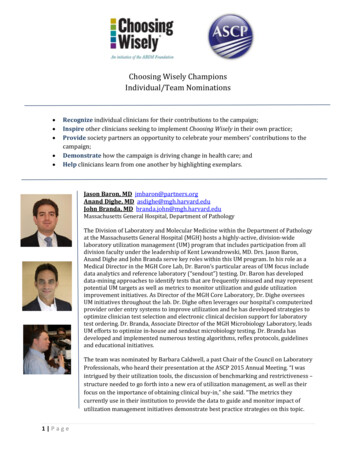
Transcription
Choosing Wisely ChampionsIndividual/Team Nominations Recognize individual clinicians for their contributions to the campaign;Inspire other clinicians seeking to implement Choosing Wisely in their own practice;Provide society partners an opportunity to celebrate your members’ contributions to thecampaign;Demonstrate how the campaign is driving change in health care; andHelp clinicians learn from one another by highlighting exemplars.Jason Baron, MD jmbaron@partners.orgAnand Dighe, MD asdighe@mgh.harvard.eduJohn Branda, MD branda.john@mgh.harvard.eduMassachusetts General Hospital, Department of PathologyThe Division of Laboratory and Molecular Medicine within the Department of Pathologyat the Massachusetts General Hospital (MGH) hosts a highly-active, division-widelaboratory utilization management (UM) program that includes participation from alldivision faculty under the leadership of Kent Lewandrowski, MD. Drs. Jason Baron,Anand Dighe and John Branda serve key roles within this UM program. In his role as aMedical Director in the MGH Core Lab, Dr. Baron’s particular areas of UM focus includedata analytics and reference laboratory (“sendout”) testing. Dr. Baron has developeddata-mining approaches to identify tests that are frequently misused and may representpotential UM targets as well as metrics to monitor utilization and guide utilizationimprovement initiatives. As Director of the MGH Core Laboratory, Dr. Dighe overseesUM initiatives throughout the lab. Dr. Dighe often leverages our hospital’s computerizedprovider order entry systems to improve utilization and he has developed strategies tooptimize clinician test selection and electronic clinical decision support for laboratorytest ordering. Dr. Branda, Associate Director of the MGH Microbiology Laboratory, leadsUM efforts to optimize in-house and sendout microbiology testing. Dr. Branda hasdeveloped and implemented numerous testing algorithms, reflex protocols, guidelinesand educational initiatives.The team was nominated by Barbara Caldwell, a past Chair of the Council on LaboratoryProfessionals, who heard their presentation at the ASCP 2015 Annual Meeting. “I wasintrigued by their utilization tools, the discussion of benchmarking and restrictiveness –structure needed to go forth into a new era of utilization management, as well as theirfocus on the importance of obtaining clinical buy-in,” she said. “The metrics theycurrently use in their institution to provide the data to guide and monitor impact ofutilization management initiatives demonstrate best practice strategies on this topic.1 Page
Dana Altenburger, MD, FASCP, FCAP dana.altenburger@advocatehealth.com, ILMedical Director of the Laboratory at Advocate BroMenn and Eureka HospitalsDana Altenburger, MD, FASCP, has successfully implemented strategies of appropriatetest utilization. As Chair of the Advocate Bromenn Medical Center’s Blood UtilizationCommittee, she has decreased inpatient blood product usage by 46% over the past threeyears. In conjunction with local allergists, she has reduced screening batteries forallergy testing. Aligning with the cardiologists, she has eliminated CK-MB testing formyocardial infarction. Virtually all 1, 25-OH vitamin D tests (in lieu of 25 Vitamin D)have been eliminated unless certain criteria are met. She has eliminated certaincoagulopathy testing, ( i.e. MTHFR) and has eliminated the work up for clottingdisorders for patients who develop a first episode of deep vein thrombosis (DVT) in thesetting of a known cause. She eliminated hypercoagulable testing for in patients withacute thrombotic events, delaying this until the appropriate outpatient venue. She hasnearly eliminated the erythrocyte sedimentation rate (ESR), replacing it with C-reactiveprotein (CRP) test.“I knew this was something I could do as a pathologist to provide a benefit to ourhospital. It’s a concrete thing where you can see the results,” said Dr. Altenburger.2 Page
Scott Weingarten, MD scott.weingarten@cshs.orgEllen Klapper, MD ellen.klapper@cshs.orgCedars-Sinai Health System, CAScott Weingarten, MDSenior Vice President, Chief Clinical Transformation OfficerCedars-Sinai Health System integrated more than 100 “implementable” (i.e., a computerwould have to understand the recommendation) Choosing Wisely recommendationsinto its electronic health record system. The health system created alerts for orderingproviders throughout the hospital, medical group, and many of its private practicephysicians. “We believe that we are the first health system in the country to ‘hard wire’ alarge number of Choosing Wisely recommendations into our EHR,” says Dr. Weingarten.Cedars-Sinai first implemented the vitamin D screening recommendation and foundreasonable acceptance by physicians to the alert. By looking at cancelled orders anddecreased rate of ordering per 1,000 patients, annualized cost-savings of over 400,000were found from the single vitamin D recommendation alone. These, and many otherrecommendations, have been translated into day-to-day practice. In the aggregate,Cedars-Sinai has seen an annualized cost-savings of more than 6 million per year andimproved the quality and safety of care from implementing Choosing Wiselyrecommendations across the health system.Ellen Klapper, MDMedical Director, Division of Transfusion Medicine Cedars- Sinai Medical Center, Dept ofPathologyPast President for California Society of PathologistsDr. Klapper has collaborated with specialists from throughout the hospital to come to aconsensus to use evidence-based, best practice guidelines for utilization for all bloodcomponents. These guidelines were subsequently integrated into electronic medicalrecord system and best practice alerts were created that pop up and notify the orderingprovider should the patient falls outside of those guidelines. These efforts have led to asustained reduction in transfusions outside the established guidelines and thattranslates into improved patient safety because unnecessary transfusions have thepotential to expose the patient to known risks, without evidence of benefit. Thelaboratory has also introduced several processes into the electronic ordering system toreduce duplicative and unnecessary test requests.3 Page
Conrad Schuerch, MD, Chairman Dept. of Lab Medicine cmattinger@geisinger.eduKelly Baldwin, MD, NeurologyBrandi Bradrick, Laboratory Financial ManagerJeanene Contreras, Core Laboratory ManagerHarold Harrison, MD PhD, Clinical Pathology DirectorN Sertac Kip, MD PhD, Molecular PathologyTroy Klinger, Program Director ITPhilip Krebs, Director Medical Policy and Appeals, Geisinger Health PlanDiana Kremitske, MS, MHA, MT (ASCP), VP Laboratory OperationsJordan E Olson, MD, Director of Laboratory Pre-analyticsDean Parry, RPh, AVP Pharmacy Clinical InformaticsBonnie Salbert, DO, Pediatric GeneticsWayne Short, SCPM, Laboratory IT Program DirectorPatricia Tsang, MD, Laboratory Medical DirectorMarc Williams, MD, Director Genomics Medicine InstituteMike Weaver, MT (ASCP), Analytical Specialist, Referred TestingBret Yarczower, MD, Sr. Medical Director, Geisinger Health PlanGeisinger Medical Laboratories Test Utilization Committee, Geisinger HealthSystem, Danville, PAThe Geisinger Medical Laboratories test utilization efforts formally began in 1996 andevolved over time to a broader purpose of assuring the medical appropriateness oflaboratory testing, developing systems and policies regarding use of laboratory testsand facilitating standardized laboratory utilization practices. Various methods areemployed by the Geisinger Laboratory Utilization Committee to fulfill this charge. Thecommittee operates with a multidisciplinary, team-based approach comprised oflaboratory professionals from various levels – pathologist director and staff, physiciansfrom clinical specialties and Geisinger Health Plan Company, and participants fromfinance, clinical informatics and pharmacy.The group has tackled various test utilization opportunities in anatomic and clinicalpathology using a variety of modalities to effect change. Among these efforts includeroutine review of test utilization data, provider education and feedback, accessibleconsultative services from pathologists, communication tools, test preauthorizationprocesses linked in the electronic health record (EHR), reflex testing protocols, decisionsupport and order set tools in the EHR, and elimination of select, inpatient standingorders. Also blood management tactics supported by a system Transfusion MedicalDirector and hospitalist infrastructure produced remarkable results in reducing bloodtransfusions.4 Page
Ilan Rubinfeld, MD, MBA irubinf1@hfhs.orgAssociate Chief Medical OfficerHenry Ford Health System, MINaAs Associate Chief Medical Officer, Dr. Rubinfeld has spearheaded several laboratoryrelated initiatives and projects, including his roles in the system-wide MedicalLaboratory Formulary Committee (MLFC) and Laboratory Utilization Taskforce (LUTF)and integrating them with the health system’s Epic councils. The system’s novelLaboratory Formulary mechanism helps the lab collaborate with clinical peers, improveprovider workflow, and mine data to identify opportunities for cost-effective andmedically-indicated laboratory testing in both inpatient and outpatient settings. Thiswork is done under the aegis of the 13-member MLFC (on which Dr. Rubinfeldrepresents the hospital providers) that comprises executive level system leaders. UnderMFLC, the multidisciplinary LUTF now includes more than 20 members from primaryand specialty care, Epic, finance and analytics, and has more than 12 projects aroundlaboratory utilization and Choosing Wisely recommendations in the pipeline. Thisconsortium has worked on several projects, including reduction of overutilization oftroponin testing and eliminating the ordering of daily labs. Dr. Rubinfeld has metpersonally with every leader in nursing and operations and on the physician council toadvocate the merits of appropriate test utilization. This synergistic combination oflaboratory and system resources has allowed for the calculation of both upstream anddownstream costs and benefits, capturing the metrics and rapid deployment ofsolutions in Epic. Going beyond system resources and by leveraging Stanson Analyticstool to work with Epic, LUTF, under Dr. Rubinfeld’s leadership, will coordinate and serveas the node for implementation of more than 70 laboratory testing-related ChoosingWisely recommendations across the health system.5 Page
laboratory utilization management (UM) program that includes participation from all division faculty under the leadership of Kent Lewandrowski, MD. Drs. Jason Baron, . LUTF, under Dr. Rubinfeld's leadership, will coordinate and serve as the node for implementation of more than 70 laboratory testing-related Choosing Wisely recommendations .










